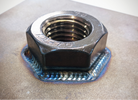
Nut Detection, Part 2
, by Jim Ryan, 1 min reading time

, by Jim Ryan, 1 min reading time
Today we have through-substrate detection. Part 1 is here.
In this case we have a 5 mm prox operating as a probe, poking through a hole to side sense the nut. The video below uses the same application detail:
The inductive proximity sensor is not a programmable prox like the one you saw in Part 1. No programming is required. Here's how it works:

It is Weld Dynamix's un-shielded, all-stainless face and body 5 mm Z-PROX sensor - coated in ACTIVSTONE for durability.

Here it is in action:
Now, let's consider what we've seen in Part 1 and Part 2 of this little series of posts.
If you need the sensor sense a nut on the other side of a metal plate, then a programmable sensor with teach capablility may be the best solution. It is amazingly versatile! But if certain tolerances cant be kept (refer to PART 1) you might consider inserting a probe to side-sense the nut, which we refer to as "through-substrate detection" since the sensor is inserted through the hole in the substrate.
This method is simple, potentially avoids fixture modifications, parameter configuration (or "teaching"), and is highly tolerant of placement/part variables.